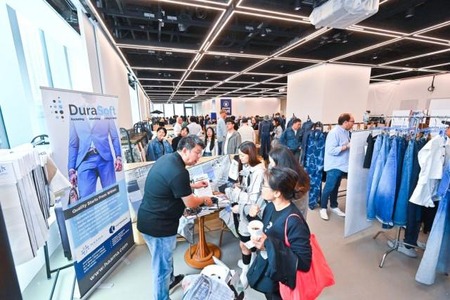
Bayeux chic the next big thing
YarnsandFibers News Bureau 2019-08-20 13:05:00 –Fashion is no stranger to a historical reference – from 1970s flares à la Once Upon a Time in Hollywood to 19th-century pie-crust collars the likes of which have had people swooning over a trailer for a new adaption of Little Women.
But lately it’s also been looking even further back, embracing a love of tapestry and all things Bayeux chic.
At Givenchy’s latest menswear show, models wore tapestry coats inspired by the poet Charles Baudelaire. At Lanvin’s poolside Parisian show, intarsia knits of seascapes borrowed from the tapestry aesthetic, while as part of a collection entitled Orlando, Comme des Garçons’ Rei Kawakubo added tapestry-like elements to clothes. “Alongside tapestry proper … historic needlepoint designs, often called tapestry, are also appearing on the catwalk,” said Elisabeth Murray, fashion curator at the V&A. The recent Gucci Tapestry Backpack, which is in fact made from velvet lurex jacquard fabric, marries back-to-school with Liberace style.
On the high street, the aesthetic is appearing via easier and cheaper-to-achieve prints. At River Island, brown tapestry print appears like a magic eye on skinny smart trousers, and on Asos the very contemporary “muscle fit” tee is given an 11th-century twist with an all-over tapestry print.
Tapestry is a technique that has been used in clothing for hundreds of years, according to Murray – the V&A boasts Turkish woven mules from the 1870s and tapestry-woven tunics from as early as 7th-century Egypt amongst its collection.
So what’s behind this throwback to the very old school? Fashion historian Tony Glenville thinks it ties in to the resurgence of crafts more broadly. There was, he said, a new appreciation of the time and concentration that goes into the kind of skills that our mothers and grandmothers took for granted, such as knitting and embroidery which offer “something during our turbulent times”. From the leather-makers at Mulberry to Jonathan Anderson, the current creative director at Loewe who has called craft “an antidote to digital media”, at a time when sustainability and slow fashion are taking centre stage.
For London-based menswear designer Edward Crutchley, who has made the tapestry-like technique of Jacquard part of his brand’s DNA, the technique is one way of creating pieces that have more “evidential worth”.
Advertisement
“I think Jacquard’s a really good way to do that – you can create something that feels immediately rich and it gives people an understanding… this isn’t printed, it’s woven – they’re buying something that is worthwhile,” and therefore not disposable, he said.
But while tapestry and similar techniques might bring to mind the Battle of Hastings, its use by fashion designers now feels far from archaic. At streetwear label Off-White, a recent design on a hoodie and tracksuit bottoms showed a traditional-looking woven artwork, while Crutchley plans to incorporate more contemporary yarns, such as flat copper or holographic lurex, into his Jacquard, to give a contemporary twist to upcoming Jacquard designs.
According to Murray: “In many collections its use seems to be grounded in ideas of historicism with the garments also drawing on other historic silhouettes and techniques alongside tapestry.” But, she added, it is also often “juxtaposed with an incredibly modern design to create something entirely new”.
Courtesy: The Guardian
Market Intelligence
Ask for free sample Report

experience
Customer Base
dedicated team
Countries Served Worldwide









